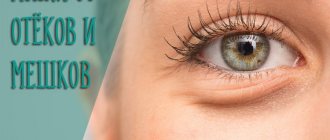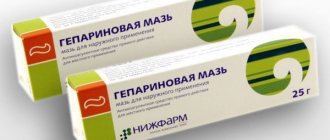Universal eye drops that relieve swelling
Such drugs are appropriate when the cause of ocular swelling is unknown or there are several negative factors at the same time. Universal drops are usually used as symptomatic treatment - they relieve swelling and a number of other unpleasant symptoms, but do not eliminate the cause of their occurrence.
Visine
This drug is an α-adrenergic agonist and is based on tetrizoline hydrochloride. Drops provide a vasoconstrictor effect and relieve eye swelling. They begin to act in a minute, the result lasts up to 8 hours.
The drug is used for swelling and hyperemia of the conjunctiva caused by chemical and physical factors or an allergic reaction.
The average cost of Visine (15 ml) is 300 rubles.
Okumetil
These drops are considered antiallergic, but provide a complex effect thanks to three components in the composition: zinc sulfate, naphazoline hydrochloride and diphenhydramine hydrochloride. The combination of these substances provides a vasoconstrictor, antiseptic, anti-inflammatory, astringent, and drying effect.
The drug is used for conjunctivitis, eye irritation accompanied by swelling, redness, itching, and foreign body sensation.
Okumetil (10 ml) costs an average of 200 rubles.
Anti-allergy drops
An allergic reaction causes itching in the eyes, swelling, and uncontrollable lacrimation. To get rid of these and many other symptoms, doctors recommend using specialized drops against inflammation and allergies.
| Opatanol | Very good drops. Consist of olopatadine solution. This substance is considered one of the most powerful antihistamine compounds. The product is characterized by high efficiency and long-lasting effect. Suitable for long term use. Allowed for children over 3 years old. |
| Allergodil | Contains azelastine. It is considered a drug with “urgent” action. Instantly relieves swelling, hyperthermia of the eyelids, eliminates itching and the feeling of “dry” eyes. Can be used for a long time, but only under the supervision of a specialist. |
| Ketotifen | Consists of clenbuterol hypochloride. This compound strengthens the mucous membrane, normalizes the viscosity of tears, and promotes the regeneration of damaged tissues. At the same time, it blocks mast cells and eliminates visible signs of an allergic reaction. |
| Vizin alert | A unique composition that allows you to simultaneously get rid of inflammation, redness and restore normal lacrimation. It is an improved prototype of the drops of the same name. Not allowed for use during pregnancy, when wearing lenses, or for children under 12. |
Antibacterial drops for eye swelling
Antibacterial drugs in ophthalmology are used to treat various infectious diseases. The patient can be prescribed a broad-spectrum medicine, but it is most effective to first identify the causative agent of the infection in order to select the most effective option in a particular case.
Sulfacyl sodium
The drug is a sulfonamide and is based on sodium sulfacetamide monohydrate. The bacteriostatic effect of the drug applies to gram-positive and gram-negative bacteria: streptococci, pneumococci, gonococci, E. coli, chlamydia, actinomycetes.
When using sodium sulfacyl, most of the drug acts locally, but a certain part of it ends up in the systemic circulation. Drops are used in complex treatment for conjunctivitis, blepharitis, purulent corneal ulcer, gonorrheal and chlamydial eye lesions.
Sulfacyl sodium (5 ml) costs about 65 rubles.
Tsiprolet
These eye drops belong to the antimicrobial drugs of the fluoroquinolone group. The active substance is ciprofloxacin hydrochloride. The medicine is used for various eye infections, as preoperative prophylaxis, as well as treatment and prevention of infectious complications after injury.
The average cost of Tsiprolet drops (5 ml) is 55 rubles.
Tobrex
The drug belongs to aminoglycosides and is a broad-spectrum antibiotic. Drops are based on tobramycin. They are prescribed for the prevention of postoperative complications and treatment of eye infections: conjunctivitis, blepharitis, keratitis, iridocyclitis.
The cost of Tobrex (5 ml) is on average 175 rubles.
Levomycetin
This broad-spectrum antibiotic is based on chloramphenicol. It is used for conjunctivitis, keratitis and blepharitis, if the microorganism that caused them is sensitive to the drug. Drops can be used in children from one month of age.
The cost of Levomycetin (5 ml) is on average 20 rubles.
Antibiotic drops for inflammatory processes
Depending on the cause of the irritation, ophthalmologists may prescribe steroid eye drops for eye inflammation. They contain at least one active component characterized by a high spectrum of action.
| Albucid | This is a solution of sodium sulfacyl. Used to treat bacterial conjunctivitis, eyelid diseases and some types of fungal diseases. Due to its aggressive action, it is recommended to drip Levomycetin along with this antibiotic - it will speed up the recovery processes. |
| Vitabact | The composition includes piloskidine, which blocks the proliferation of various pathogenic microorganisms that cause inflammatory processes. Used to treat conjunctivitis, trachoma, keratitis. Not recommended for use in children under 8 years of age. |
| L-Optic | The active component of the drug is levofloxacin hemihydrate. It is an antimicrobial substance with an extremely broad spectrum of action. In ophthalmology it is used to treat bacterial inflammation, blepharitis, and dry eyes. Prescribed for pregnant women and children over 1 year of age. |
| Tsiprolet | Contains ciprofloxacin hydrochloride. It is prescribed for the treatment of various bacterial eye diseases (including ulcers), acute inflammatory processes, and also to accelerate tissue recovery. Contraindicated for use in pregnant women. |
| Uniflox | The drops contain ofloxacin, making the drug a new generation antibiotic. Prescribed for the treatment of keratitis, ulcers, and inflammation caused by other pathogenic organisms sensitive to the main component. |
| Tobrex | Urgent drops to relieve inflammation. Almost instantly eliminates redness and itching, thanks to tobramycin in the composition they accelerate the restoration of the mucous membrane. Approved for use by children over 3 years old. |
| Chloramphenicol | This is an analogue of Levomycitin. Inexpensive drops that quickly combat redness of the mucous membrane, swelling and bacterial exposure. Helps moisturize the cornea. |
These medications can only be prescribed by an ophthalmologist who performed the examination and tests.
Anti-inflammatory non-steroidal drops
Drugs in this group provide anti-inflammatory and analgesic effects, which eliminate not only eye swelling, but also other symptoms. NSAIDs inhibit the action of the enzyme cyclooxygenase, which is involved in the production of prostaglandins involved in the development of the inflammatory process.
Diklo-F
The medication is based on diclofenac. Drops are used to eliminate swelling caused by infection, injury, or surgery. The maximum concentration of the drug is achieved within half an hour.
The cost of Diklo-F eye drops (5 ml) averages 85 rubles.
Indocollier
These drops are NSAIDs and are based on indomethacin. It inhibits the synthesis of prostaglandins, which relieves pain and inflammation and eliminates the swelling caused by it. Drops are suitable for long-term use, but for no more than a month. The drug is used for treatment and prevention, including after surgery or injury.
The cost of Indocollir (5 ml) is on average 330 rubles.
Prevention of eyelid swelling
If the patient has a predisposition to swelling of the eyelids, preventive measures must be taken to prevent the formation of large amounts of fluid under the skin:
- compliance with the drinking regime;
- proper nutrition, including food containing all the nutrients, trace elements and minerals necessary for the normal functioning of the body;
- the use of high-quality cosmetics, which may contain a hypoallergenic composition, which eliminates the development of allergic reactions (it is necessary to check the expiration date);
- correct use of cosmetics, excluding excessive application with subsequent accumulation of substances in the pores and ducts of the glands;
- daily facial cleansing procedures, since even a small amount of cosmetics and glandular secretions can accumulate in the ducts, clogging them;
- daily use of eye exercises;
- daily use of massage for the entire face, including the eyelids, which stimulates lymphatic drainage and blood flow.
Prevention methods will not always be able to prevent swelling of the skin on the face. They only reduce the risk of its occurrence.
Antiallergic drops
These drugs are used for symptomatic treatment, as well as the prevention of allergic reactions. In addition to swelling of the eyes, allergies are usually accompanied by itching, watery eyes, and redness. Antiallergic drops can relieve these unpleasant symptoms.
This article will tell you how to choose the right eye drops for allergies.
Lecrolin
This drug is based on sodium cromoglycate, is an antiallergic agent and a stabilizer of mast cell membranes. Drops are used for allergic conjunctivitis and keratitis, irritation of the mucous membrane against the background of an allergic reaction. The drug acts most effectively as a prophylactic agent.
Lecrolin (10 ml) costs about 95 rubles.
Opatanol
These antiallergic drops are based on opatanol hydrochloride, a selective inhibitor of H₁-histamine receptors. This substance also provides a blockade of the release of inflammatory mediators from mast cells. The drug has a pronounced antiallergic effect and is prescribed for allergic conjunctivitis.
The cost of Opatanol (5 ml) is about 435 rubles.
Allergodil
This drug is based on azelastine hydrochloride and is a H₁-histamine receptor blocker. The medicine has a strong antiallergic effect and provides a long-lasting effect. Allergodil is prescribed for the treatment and prevention of allergic conjunctivitis, including seasonal ones.
The average cost of the drug (6 ml) is 400 rubles.
Types of drops
As a remedy for inflammatory processes, experts prescribe drops with steroidal, non-steroidal and combined components.
Types of eye drops:
Types of eye drops for inflammation
- Steroid
used to treat inflammatory processes caused by infections. They are also used to eliminate the autoimonic component. But, at the same time, they are not able to eliminate the bacterial causes of inflammation, but only relieve symptoms;Antibiotics for eye inflammation
- Non-steroidal or anti-infective
. They are used similarly to steroids, but in simpler cases. Can be used in combination with antiviral or antihistamine drugs. Despite the low likelihood of side effects, drops from this group cannot be prescribed to yourself;Antiviral drops for inflammation
- Combined
. They combine the action of an antibiotic component and an anti-inflammatory component. Thanks to this tandem, they simultaneously eliminate the cause and effect of the disease. It is most widely used in the treatment of bacterial or fungal eye diseases.Antimicrobial eye drops
Also, an acute inflammatory process can occur against the background of an allergic reaction. When histamine is released, changes occur in the mucous membrane. This reduces its protective function, making it much easier to become a victim of infection or bacterial irritant.
Anti-allergenic drops
To treat allergic inflammation of the mucous membrane, specialized drops are used that block the release of histamine. Most of them are characterized by a high speed of action and duration of effect.
Hormonal drops (corticosteroids)
Corticosteroid medications are often used for serious infections and autoimmune diseases. The advantage of corticosteroids is that they have a more pronounced effect. They provide anti-inflammatory, antiallergic and analgesic effects.
Maxidex
This drug is a corticosteroid and is based on dexamethasone. It is prescribed for non-infectious inflammatory processes and allergic reactions. The use of Maxidex is appropriate when the conjunctiva, cornea or anterior segment of the eye is affected.
The average cost of the drug (5 ml) is 265 rubles.
Betakortal
The medicine is based on betamethasone disodium phosphate. The drug provides anti-inflammatory, anti-allergic and anti-exudative effects. It is used for severe inflammatory and allergic eye diseases of an acute or chronic nature. Drops are used not only in ophthalmology, but also in ENT practice.
The average cost of Betacortal (5 ml) is 115 rubles.
General rules for using eye drops
You need to use eye drops in accordance with the instructions, since different drugs may have their own application characteristics. Several general rules should also be highlighted:
- maintaining hygiene - before using the drops, be sure to wash your hands thoroughly with soap;
- During treatment, the use of decorative cosmetics and aggressive agents should be avoided;
- if a separate pipette is used to instill the drug, then it must be boiled each time or at least doused with boiling water;
- if the drops should be stored in the refrigerator, then they must be taken out an hour before use, otherwise the affected area may become hypothermic and the symptoms may worsen;
- when instilling, do not touch the eye with a pipette or dropper;
- while instilling the drug, you must lie down or tilt your head back - you must remain in this position for at least a minute after treating the eyes;
- when using several drugs in the form of drops simultaneously, wait at least 5 minutes between eye treatments;
- strictly follow the dosage regimen prescribed by the doctor or indicated in the instructions - duration of treatment and number of treatments per day;
- During treatment, contact lenses should be abandoned, especially for diseases of infectious origin.
Most ophthalmic drops have a shelf life of 2-3 years. This is only valid for unopened medicines. After opening the bottle, the drops can be used for a limited time - usually no more than a month. After this period, the drug cannot be used.
Eye drops are one of the main forms of ophthalmic preparations for topical use. They are used for the treatment and prevention of various diseases, allergic reactions and complications, including those accompanied by eye swelling. Eye drops must be used according to certain rules.
How to use drops
Brief instructions for using eye drops:
- You need to wash your hands thoroughly and wipe your eyes with Chlorhexidine solution. This will remove pathogenic microorganisms and clean the outer surface of the eye;
- Gently pulling back the lower eyelid, you need to drop the number of drops indicated in the instructions into the eye sac;
- Excess product must be removed using a sterile cotton swab.
For some time after instillation, there may be unpleasant sensations: blurred vision, tearing or a slight burning sensation. If these symptoms do not go away within 10 - 15 minutes, then the remedy is not suitable for you and it is recommended to choose another drug.
RATE THIS ARTICLE:
(
ratings, average:
out of 5)
Publication date: 2017-02-01 | Our health
www.LadyWow.ru
Constant hard work, the modern fast pace of life, the desire to cope with a huge number of things leave a certain imprint not only on the internal physical and emotional state of the body, but also on a person’s eyes. Despite an impeccable wardrobe and makeup, fatigue can be seen in the eyes of a person trying to do everything; to mask this fatigue, people use eye drops.
The reasons why eyes get tired are known to many. This is a lack of sleep, a long stay at the computer monitor, TV screen. Eye fatigue is familiar to drivers who are forced to be on the road for a long time, as well as to young owners of mobile devices with interesting games and the ability to access the Internet.
Eye fatigue is characterized by swelling of the eyelids, redness of the eyeballs, dryness of the mucous membrane of the eye, a feeling of discomfort and the presence of a foreign object on the cornea. Sometimes there is a bursting pain and burning sensation in the eyes, which intensifies under the influence of light.
Why does swelling occur?
To choose a truly effective remedy for puffy eyes, you first need to find out what causes this phenomenon. The skin under and around the eyes is very thin and sensitive. It needs constant hydration, quickly dries out under the influence of external factors, easily loses its tone and becomes wrinkled prematurely due to insufficient nutrition.
But under the thin skin there is loose fatty tissue. It has high hygroscopic properties, that is, it intensively absorbs moisture and retains it. If, under the influence of any factors, the balance of fluid in the body is disturbed, tissues of a similar structure are immediately filled with moisture. Visually, this manifests itself as swelling of the upper and lower eyelids.
Factors that provoke the formation of bags under the eyes can be divided into two large categories: pathological and non-pathological. Non-pathological ones include:
- Excessive consumption of salt and salty foods, especially before bed.
- Abuse of alcoholic beverages - alcohol can initially act as a diuretic, but then, on the contrary, it absorbs and retains fluid in the tissues.
- Eye strain during any work, even, at first glance, imperceptible, chronic fatigue.
- Reaction to aggressive external stimuli - polluted, smoky air, chemical fumes, ultraviolet radiation, wind, chlorinated or sea water, etc.
- Prolonged crying.
The main pathological provoking factors are as follows:
- Allergic reaction to food, medications; external irritants, dust, plant pollen, animal hair, etc.
- Any inflammatory processes of the organs of vision.
- Congenital abnormalities in the development of eye structures, in particular the upper and lower eyelids.
- Lymph circulation disorders.
- Diseases of internal organs and systems that can affect the circulation of fluid in the body and its elimination.
- Oncological pathologies.
- Injuries to the organs of vision.
If swelling occurs only occasionally and is caused by non-pathological causes, then serious pharmaceutical decongestants are not needed. It is enough to adjust your daily routine and diet, give up bad habits if possible - and the swelling will go away on its own. Gentle diuretic folk remedies for swelling under the eyes will help speed up the process.
If the swelling on the face takes on a permanent, chronic nature, accompanied by swelling in the arms and legs, you will need a more radical remedy for swelling - tablets, drops or special herbs with a pronounced diuretic effect. Only a doctor can tell you which ones after a comprehensive examination - after all, when treating one problem, it is important not to harm other organs and not to add new ones.
Causes
Features of the anatomy and physiology of the organs of vision make them sensitive to allergens, most of which live in the air. This could be dust, pollen, wool, chemical fumes, etc.
Food allergies in the eyes or reactions to medications and cosmetics are much less common.
Allergies in the eyes: photo
There is such an allergic reaction of the eyes, as a result of which the ability to control the motor activity of the upper eyelid is completely lost. It is very important to differentiate allergic manifestations from the inflammatory process in the organs of vision, conjunctivitis.
If your eyes are swollen, red, or itchy, you need to be completely examined by an allergist .
Swelling under the eyes of a child is a reason to visit a specialist!
The specialist takes the following tests:
- skin tests with allergens;
- scraping from the conjunctiva;
- study of secretions from the lacrimal glands.
Vision is also checked and eye biomicroscopy is performed.
When are serious diuretics needed?
If a person had fun all night at a party with friends or simply drank a lot of liquid before going to bed, the next morning he may be upset by noticeable swelling under the eyes. Naturally, everyone wants to quickly remove ugly bags, especially if they have to go to work or an important event. But you should not do this with the help of potent diuretics. All tablets from this group have a number of contraindications and side effects; they may eliminate one-time swelling, but at the same time they can disrupt some functions of internal organs.
Pharmacy medications with active ingredients are needed in the following cases:
- The swelling does not decrease throughout the day; on the contrary, in the evening swelling appears on the arms and legs too.
- The swelling becomes larger over time and spreads to the cheekbones.
- The bags take on a dark color.
- Due to edema, a noticeable narrowing of the palpebral fissure develops (in severe cases, edema provokes displacement of the eyeball).
With such symptoms, effective medications are needed to eliminate edema, but first you need to diagnose and accurately determine the cause. And only a professional doctor can do this. As a rule, constant swelling under the eyes is not an independent pathology, but only a consequence of a malfunction of any internal organs and systems. It is imperative to establish which ones and carry out appropriate treatment. Otherwise, even the best and most expensive diuretic will not help. The problem will be solved, but not for long, and over time the swelling will bother you again.
What is eyelid swelling
This is a symptom that represents an excessive accumulation of fluid in the subcutaneous fatty tissue of the eyelids, resulting in their swelling. The common cause of this pathology is various diseases of a local or general nature. Swelling of the upper eyelid is most common, but sometimes it also occurs in the lower eyelid. The attack can be single or recurrent. Edema can develop at any age, but men and women over 30 are more prone to it.
In general, the eyelid is a fold of skin that protects the eyes from possible dangers, such as dust and bright flashes. It consists of two layers:
- Anterior, or superficial . This is the musculocutaneous layer that provides blinking. The muscle includes two parts: palpebral and orbital.
- Posterior, or deep . This is the conjunctival-cartilaginous layer. The cartilage of the eyelids consists of dense connective tissue located under the eye muscles.
Most of the human body is fluid. It occupies almost 70% of the total volume. Part of the fluid is located inside the cells, the rest is in the space between them. Swelling of the eyelid in one eye develops when the amount of water in the intercellular area becomes above a critical value of 1/3 of the total volume. Depending on the reason it happens:
- membranogenic - develops due to increased permeability of vascular walls to water and molecular substances;
- hydrostatic – associated with a decrease in the pressure of the same name inside the capillaries and tissues;
- hypoproteinemic - is a consequence of a decrease in colloid osmotic pressure.
Depending on the location, swelling is divided into bilateral and unilateral (on the right or left eye). These types are practically no different. Swelling of the lower eyelid is observed less frequently; swelling of the upper eyelid occurs more often. In the first case, cardiovascular diseases may be a serious cause. Taking into account the cause, edema is classified into:
- Inflammatory . Accompanied by pain, redness, and hyperemia of the skin. This type of inflammation is characteristic of eyelid swelling in one eye.
- Allergic . Also called angioedema. The eyelid doesn't hurt, it just itches. There are no other symptoms. When a child's upper eyelid is swollen, the most common cause is allergies.
- Non-inflammatory . The skin color remains normal or pale, there is no pain, as well as a local increase in temperature. Swelling of this type is often bilateral and occurs mainly in the morning.
- Traumatic . Characteristic of the condition after tattooing, in which pigment is driven under the skin to create a makeup effect. The cause can also be other trauma to the eyelids, for example, microtrauma when wearing contact lenses.
Inflammatory edema
This type of deviation is associated with infectious lesions of the eyes, and less often with other diseases, such as acute respiratory viral infections, sinusitis, sinusitis and other inflammations of the sinuses. Such pathologies are accompanied by:
- burning;
- itching;
- tingling;
- photophobia;
- tearfulness.
Similar symptoms in the case of colds develop more often in both eyes. If only one eyelid is swollen, then the likely cause is infectious pathologies of the organs of vision. The list of such diseases includes:
- Barley . It is formed after pathogenic bacteria, most often Staphylococcus aureus, enter the surface of the eyeball. The infection is an inflammation of the hair follicle of the eyelashes. The eyelid turns red, swells, and hurts when pressed.
- Conjunctivitis . Inflammation develops in the mucous membrane of the eye. Redness appears. There is a feeling of a foreign body or sand in the eye. There is photophobia and discharge of pus or clear fluid.
- Blepharitis . This is a chronic disease accompanied by inflammation of the edge of the eyelids, which swells.
- Dacryocystitis . Characterized by inflammation of the lacrimal sac. Dacryocystitis is indicated by pain, redness, and swelling of the eyelids. Symptoms are localized closer to the inner edge of the eye.
- Infectious and inflammatory diseases . These include abscess and phlegmon of the orbit, which develop as a result of bacteria entering the wound. In this case, the eyelid swells and hurts very much. In more severe cases, body temperature rises, general weakness and headache appear.
- Erysipelas lesions . This is a serious infectious disease that causes general intoxication of the body and inflammatory skin lesions. It can also cause swelling of the eyelid in one eye.
Allergic swelling of the eyelids
The clinical picture of allergic edema of the eyelid in one eye differs from inflammatory edema. Symptoms develop suddenly. Itching and swelling appear on the eyelid, it turns red. A person feels discomfort in the area of the affected eyeball. Skin rash, nasal congestion, and tearfulness also indicate the allergic nature of the disease. This reaction can be caused by:
- household chemicals;
- cosmetical tools;
- animal hair;
- plant pollen;
- insect vinegars;
- food products;
- hygiene products.
Allergic edema is classified into two types based on the symptoms and their severity. Based on these characteristics, the following are distinguished:
- Allergic dermatitis . Accompanied by not very strong swelling. Characteristic symptoms are itching and redness.
- Quincke's edema . Unlike the previous type, on the contrary, it causes severe swelling, which does not even allow a person to open his eyes. There are no other signs. This condition is dangerous because it can spread to the respiratory system.
Traumatic edema
Due to the soft and very delicate tissue, the eyelids are easily injured. Swelling may appear as a result of a burn, bruise or other mechanical stress. No specific treatment is required. Therapy is aimed at reducing symptoms and preventing purulent complications. This requires maintaining eye hygiene. There are other causes of traumatic swelling:
- Tattoo procedure . Involves driving pigment under the skin. Swelling develops due to too deep exposure. If the procedure is carried out correctly, the symptom disappears on its own after a day.
- Anatomical structure of the organs of vision . If the membrane between the fat layer and the skin is too thin, then it can swell under any negative influence.
- How to turn off Gudok on Tele2
- Egg diet for 14 days
- How to effectively treat subcutaneous mites on the face
Non-inflammatory edema
This type of deviation is most often observed in the morning after waking up. In this case, swelling of the eyelids above the eyes is accompanied by severe pain, redness and hyperemia of the skin. At the same time, the external skin looks pale and cool. The cause of this complex of symptoms may be:
- oncological eye diseases;
- violation of lymph outflow or blood circulation;
- systemic diseases of the thyroid gland, vascular system, kidneys, digestive system;
- abuse of salty foods;
- smoking and drinking alcohol;
- lack of sleep;
- eye strain.
Swelling of the eyelids in the morning
At night, fluid gradually fills the space between the cells. This occurs due to prolonged exposure to a horizontal position. Then the swelling goes away throughout the day. The main causes of pronounced swelling after sleep, which occurs regularly, are:
- diseases of the genitourinary system;
- abuse of pickles and alcohol the day before;
- first use of a new cosmetic product.
Review of the most popular diuretic drugs
Pharmacies offer a fairly wide selection of diuretic drugs that help remove excess fluid from the body, and therefore relieve swelling under the eyes. But the most effective of them are sold only by prescription and have a number of serious contraindications, so starting a course of treatment on your own is strictly not recommended.
- Furosemide. A classic diuretic with a quick effect. It is prescribed only by a doctor in cases where it is urgently necessary to eliminate severe swelling. For adults, the drug is prescribed in a strictly limited dosage: half a tablet once a day. Furosemide is not prescribed for children, adolescents, pregnant and lactating women, and elderly people.
- Veroshpiron. This medicine also helps get rid of persistent and severe swelling, but does not act as quickly as the previous one. It is prescribed to adults, one tablet per day.
- Trifas. A fairly effective diuretic that helps remove excess fluid from the body. But at the same time it has much fewer side effects and contraindications. Trifas does not affect metabolic processes and does not wash away calcium along with urine. The drug is prescribed depending on the severity of the condition, 1–4 tablets per day. The maximum effect is achieved 12 hours after the first dose.
Traditional medicine
Pharmacy medications are not the only remedies for puffiness under the eyes; there are more gentle and affordable ways to restore a healthy and beautiful appearance. Many patients with problems with the urinary system, accompanied by edema, prefer to use medicinal herbs or a mixture of them.
Diuretic herbs for puffiness under the eyes can be collected and prepared for future use yourself during the spring, summer and autumn seasons. But only if you know exactly which ones you need and are confident in their environmental friendliness. Or you can buy already dry preparations in herbal pharmacies - it’s easier, faster and more reliable. Here are the recipes recommended by traditional medicine against edema:
- Shepherd's purse. A large spoonful of dry and crushed herbs should be poured with a glass of boiling water, covered, and left for half an hour. Then strain and drink warm in one go. To achieve the desired diuretic effect, it is recommended to drink three such servings throughout the day, preferably before meals. The course of treatment continues until the swelling is completely eliminated.
- Diuretic mixture with chicory and mint. First you need to prepare a mixture of medicinal herbs. To do this, mint, chicory, yarrow, dill and nettle are combined in equal quantities. Pour a glass of boiling water over a spoon of the resulting mixture, cover tightly and leave for twenty minutes. The resulting drink can be drunk immediately or divided into two or three servings and drunk as tea every two hours. It is recommended to drink at least two such servings per day; you can sweeten the medicine with honey.
- Diuretic mixture with rose hips and St. John's wort. To prepare the mixture, St. John's wort, nettle, crushed rose hips, bearberry and plantain are combined in equal proportions. A large heaped spoonful of the resulting herbal mixture is placed in a thermos, poured with two glasses of boiling water, closed and left for half an hour. The resulting infusion is filtered and drunk throughout the day.
- Bearberry. An effective diuretic tea is prepared from this medicine. All you need is to mix a spoonful of bearberry with half a spoonful of black or green tea without flavorings or additives. The mixture is poured with a glass of boiling water, covered and left for ten to fifteen minutes. The finished medicine should be taken half an hour before meals.
- Lingonberry leaves. Lingonberry tea is suitable for treating edema in children and adolescents, as it tastes good and has a very gentle effect. But first, you should definitely consult a pediatrician or family doctor. To prepare, just pour a glass of boiling water over a tablespoon of crushed leaves and leave for twenty minutes. You can drink this tea with honey, then it will be even healthier.
To enhance the effect of infusions and decoctions of medicinal herbs, you can make eye masks. The easiest way to reduce swelling is to apply cold compresses. It is not recommended to use ice, since the skin around the eyes is very thin and sensitive, the capillaries are located close to the surface. Instead of a refreshed, rejuvenated face, you can get a completely different result. It is better to apply cotton sponges soaked in ice water.
A good home remedy for puffy eyes is a paste of parsley stems and leaves. Fresh greens are washed, shaken, then chopped and crushed in a mortar. The pulp is spread on gauze, a bag is formed and applied to the eyes for 20 minutes. Such compresses help get rid of not only swelling, but also bruises under the eyes and redness of the mucous membrane and whites of the eyes. Similarly, you can use raw potatoes, agave leaves, and fresh cucumber.
Just as there are foods and drinks that help retain fluid in the body, there are also those that help remove it. In the summer season, watermelons will help out. This is a natural and very effective diuretic with virtually no contraindications. There are even special watermelon diets, but they should be carried out only after the approval of a doctor and under constant medical supervision.
Other foods that have a diuretic effect:
- Ground cucumbers (greenhouse cucumbers from the supermarket are not suitable). They should be eaten grated with the peel, without salt or other spices.
- Dill, leaf lettuce - fresh herbs can be added to cucumbers and prepared a healthy salad.
- Black currant - this berry is useful not only as a diuretic, but also as a source of vitamins necessary for good vision.
- Pumpkin is best raw.
- Celery. Fresh juice from celery, cucumber and herbs will be very useful against puffiness under the eyes. It is better to drink it in the morning on an empty stomach. Additionally, this cocktail will perfectly cleanse the intestines.
- Fermented milk liquid products - kefir, fermented baked milk, low-fat yogurt. They are also drunk in a glass in the morning on an empty stomach.
Folk remedies, diet, and proper rest will actually help get rid of swelling. But don't expect quick results. To restore normal fluid metabolism in the body, it will take time, exactly how much depends in most cases on the patient himself, his willpower and desire to look young and healthy.
Summary: swelling under the eyes can occur for various reasons, sometimes it is a temporary phenomenon that does not require drug treatment. It is enough to adjust your daily routine, diet and habits to get rid of swelling on your face. But swelling can also be symptoms of serious problems in the functioning of internal organs. If their formation is associated with dysfunctions of the urinary system, diuretics - pharmaceutical or folk ones - will help. Any of them should be prescribed only by a doctor after a thorough examination of the patient. It is not advisable to take diuretics if edema is associated with pathologies of the endocrine or cardiovascular system.
Causes of swelling
What causes swelling is not always immediately clear. A “single” case and regular swelling will have different causes, but the problem can easily become chronic. So it’s still better to clarify this problem with a specialist.
Most often, only one eyelid swells - the upper or lower. There are more reasons why eyes and eyelids swell than one might think.
- eye damage;
- allergy;
- fatigue;
- excess salt in the body;
- cold;
- diseased kidneys;
- problems with the thyroid gland;
- weak venous outflow;
- eating excessive quantities of smoked, salty, fatty and spicy foods;
- alcohol abuse;
- coffee abuse
- a hearty dinner before bed
Symptoms and signs
Characteristic signs of allergic reactions in the eyes include:
- Dryness of mucous membranes;
- Tearing;
- Fear of bright light;
- Itching and burning. There may also be a feeling of the presence of a foreign object. Irritation becomes stronger because, as a result of itching, a person begins to actively scratch his eyelids;
- Red eyes (whites);
- Swollen eyes and eyelids;
- Appearing discharge that has a mucous consistency, sometimes even with purulent impurities;
- Frequent sneezing and allergic rhinitis;
- Concomitant skin manifestations of an allergic reaction.
What will help you get fit in the morning?
Nutrition. In the absence of particularly painful swelling and obvious pathologies in the body, it is quite possible to reduce swelling by adjusting your diet and lifestyle. You need to have dinner at least 3-4 hours before bedtime and do not drink liquid for 3 hours. At the same time, dinner itself should not be heavy.
Try studying your diet. Many foods and drinks have the ability to trap excess fluid in your body, such as salt and preservatives. It is necessary to reduce the number of such products. The best liquid to drink is plain water.
It is a known fact that drinking alcohol interferes with the removal of fluid from the body, which means it causes morning swelling.
Daily regime. Need to get enough sleep. Lack of sleep is noticeable under the eyes. The ideal would be to go to bed early and get up early in the morning. If you rest until lunch, you will also look tired.
Before going to bed, do not apply a nourishing and moisturizing cream to the area around the eyes, otherwise the eyelids will swell in the morning.
Medicine
You can go to the pharmacy and buy medications for puffy eyes. For example, diuretics. But it’s better to first see a doctor and get a prescription so as not to harm yourself with self-medication. The doctor will determine the cause of the swelling. It may be more serious than poor diet and overwork. Then folk remedies will not be enough.
There are tablets, the use of which leads to a strong diuretic effect. The result is dehydration and exhaustion of the body. Along with urine, the body will leave the microelements it needs. Including potassium and magnesium. This can lead to a malfunction of the cardiovascular and other systems.
Therefore, while taking diuretic medications, you should take vitamins and mineral complexes. They will make up for the deficiency formed in the body. If you frequently take diuretics, be sure to include potassium-rich foods in your diet.
Champions of its content:
- fresh cabbage;
- milk;
- garlic;
- bananas;
- baked potato.
Masks made from products that are always on hand help relieve eyelid puffiness. For example - one part of finely chopped parsley plus two parts of sour cream, mix under the eyes for half an hour. You can brew chamomile tea, soak cotton pads in it and place it on your lower eyelids before bed for 15-20 minutes. These procedures need to be done regularly.
If you decide to take diuretics at your own discretion, and not as prescribed by a doctor, you can harm yourself, since the cause of edema may be pathological.
Quickly relieve swelling from the eyes
Puffiness of the eyes greatly spoils a person’s appearance, making one think that he has recently cried. To get rid of this problem as quickly as possible, you need to follow these recommendations:
- changing cold and hot water has a positive effect on the eye vessels, causing them to periodically expand and contract. Finally, when you decide to finish the washing procedure, you must turn on cold water;
- A cold compress will help get rid of puffiness under the eyes in the shortest possible time. Regular ice will do for this. Just wrap it in a scarf or towel and apply it to your eyes for a short period of time (20-40 seconds);
Cold compress
- used tea bags (necessarily chilled). Apply tea bags to your eyes for about 30 minutes. This will relieve puffiness and give you a more fresh look;
- grind a few mint leaves into a paste, then make a compress from the resulting substance;
- take a diuretic (just do not exceed the recommended dose, which is indicated in the manufacturer’s instructions);
- Remove the fresh cucumber and cut it into rings. Apply them to your eyes for about 10-15 minutes.
Cucumber mask
All these methods are universal, that is, suitable for everyone. But it is worth noting that they give a temporary effect, so you need to use them before some important event where you need to look fresh. This will not eliminate the underlying problem that caused the swelling, but will only temporarily relieve the symptom. Therefore, you will need to see a doctor if the swelling does not go away.
Video: How to remove puffy eyes from eyes in 5 minutes
Local impact
The cause of swelling, bruises, and dark circles under the eyes can be trivial - age. The skin around the eyes is too thin and sensitive and is therefore most susceptible to aging. Hormonal changes in the body and weakening of sexual functions have a negative impact on the skin around the eyes. Many women wisely delay the moment of aging and turn to medicine for help. With the help of procedures, the skin around the eyes is rejuvenated and you look great.
Mesotherapy for eyes against swelling is a procedure using special preparations to restore the skin. The procedure is performed using injections with a thin needle into points around the eyes. The composition of the drug is a mixture.
Contains:
- hyaluronic acid;
- pharmaceutical and homeopathic preparations;
- minerals.
These drugs differ in properties, degree of impact and interaction of its components with each other. The composition of the drug is carefully selected separately for each woman. The condition of the skin must be taken into account, sensitivity and the presence of allergies are clarified.
Medicines are divided into:
- fixed assets,
- auxiliary means.
Basic remedies fight the cause of edema. Auxiliary products activate blood flow and include vitamins and antioxidants. Metabolic processes in cells are activated, swelling disappears, just as the hated “crow’s feet” disappear, and there is no trace left of dark circles and bags.
Mesotherapy is carried out using painkillers and lasts 15-20 minutes. In order to achieve an excellent result, the procedure must be repeated 5-7 times, once a week - ten days.
There are no age restrictions. The price of the procedure is quite acceptable for everyone. Non-toxic. There is some pain during the injection, but the small sacrifice is worth it. Adverse reactions are minor and disappear after 3-4 days.
After the procedure, you should use warm, not hot water when washing your face for 7-10 days. Refuse to visit the beach, solarium, sauna. Wear dark glasses to protect yourself from bright sunlight, do not rub your eyes, and put aside decorative cosmetics for a while. Drinking alcohol before or immediately after can reduce or destroy the expected result of the procedure.
It is important. Many professional cosmetologists do not recommend using Botox around the eyes, since the muscle is blocked and the outflow of fluid in this area is disrupted. The result is constant swelling.
Mesotherapy for eyes for swelling, dark circles, bruises, wrinkles, etc. using special preparations, it must be done by professionals and only by professionals. They will take into account everything that is contraindicated for your body and will not cause you any harm.
Traditional methods of getting rid of edema
There are available methods to combat edema. You can speed up the process of removing excess fluid from the body. Special herbal teas and some familiar products help with this perfectly.
To do this, you need to add foods to your diet such as:
- watermelon;
- parsley;
- celery;
- onion;
- garlic;
- black currant;
- pumpkin;
- any fermented milk products.
Remember. You need to consume foods with a diuretic effect long before bedtime, otherwise the water will not come out and you will sleep.
You can prepare a decoction of rose hips or the following herbs:
These simple plants are excellent remedies for puffy eyes. It will not help only if the problem is a consequence of pathologies. However, several cups of this tea will definitely not harm the body.
The decoction must be freshly prepared. Herbal infusions spoil very quickly and you can get food poisoning. Also consider your susceptibility to allergies.










